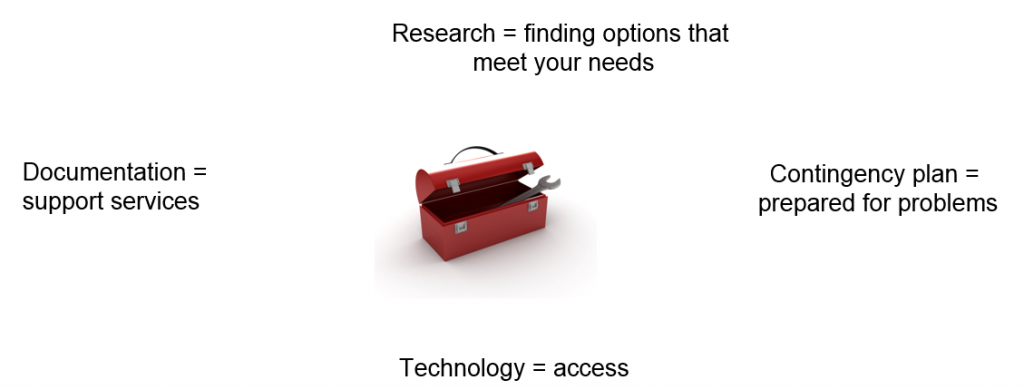Getting Students Ready for “Back To School”: The College And University Edition

Last September, I talked about getting ready to go back to elementary and secondary school. This month’s column will focus on college or university. When we think of postsecondary education, our focus is generally on high school students moving to college or university. However, as advocates for individuals with hearing loss, we also need to consider implications for adults or seniors with hearing loss who are interested in returning (or attending for the first time) to college or university, as well as thinking about college or university faculty and instructors with hearing loss. The latter population is one which has received almost no attention; yet with no mandatory retirement age for postsecondary instructors, it is inevitable that colleges and universities will need to provide accommodations for instructors with hearing loss. Effective accommodations for teaching with a hearing loss can be very different from effective accommodations for learning with a hearing loss. At the recent annual conference for the Canadian Hard of Hearing Association (CHHA) in Montreal, I presented a “toolkit” for navigating postsecondary education as a student with a hearing loss which include 4 components: Documentation, Research, Contingency Plans, and Technology.

Research
Choosing a college or university is stressful for any student; having a hearing loss means that there may be extra considerations. Fortunately, there are many, many options available.
For students who are not sure about attending college or university (or are not sure which to choose):
- Taking a “gap year” is always a possibility. Taking a year off to study, travel or work between grade 12 and postsecondary education can be an excellent option. The Ontario School Counsellors Association website at www.osca.ca has great information on gap year options. A gap year provides opportunities for academic upgrading for students who may have struggled in high school, or to explore work, travel or volunteer opportunities which will enhance a resume
- College/university partnerships can be a good option. In the past, if students attended college, any credits earned were not accepted at universities. However, virtually all Ontario universities now have partnerships with colleges, whereby there are hybrid programs and transfer pathways between college and university. A list of Ontario university-college partnerships can be found through the Ontario Universities Application Centre at www.ouac.on.ca/guide/collaborative-university-college-programs.
Considerations for Choosing a College or University

In the past, there were often significant differences in the level and quality of support services provided across institutions. In my experience, this is less true now; students can feel confident that they will receive good support services at any postsecondary institution. However, one of the realities of postsecondary education with which students with hearing loss often struggle, is class size. Researching colleges and universities online is easier than ever, and information about program sizes is often available. For example, increasingly, universities and colleges have a main site and satellite sites; often the satellite sites are smaller in general, and have smaller class sizes as a result. There may be options to attend smaller programs within a university (such as the University Colleges at Western University). Once students have narrowed their potential choices down, campus visits are strongly recommended. Students and families may even wish to make an appointment with the Student Accessibility Office during a campus visit. One of the realities of postsecondary education is that once students are enrolled, institutions will communicate only with the registered student (not with parents). Parents do not have access to any information about their students, and postsecondary institutions will only provide (some) information with written permission of the student. Parents who are accustomed to being able to communicate with school staff about issues or information, or who have been able to step in when problems have arisen, can no longer do so. Therefore, gathering as much information as possible prior to September is important to identify or anticipate potential issues.
Researching financial support is also an important consideration. Student financial aid has become more difficult to access over the years, but it is still important to investigate provincial funding. In Ontario, if students with hearing loss qualify for any amount of funding through the Ontario Student Assistance Program (OSAP), they also qualify for the Disability Bursary, which provides $10,000 for Hearing Assistance Technology, laptops, etc. Scholarships specifically for students with hearing loss may be available; the Canadian Hearing Society maintains a list of these opportunities at www.chs.ca/scholarships-and-bursaries
Documentation
All Canadian colleges and universities have a Student Accessibility Office (names may vary across institutions). Registering with the Student Accessibility Office, and obtaining an accommodations letter is key to accessing services in postsecondary education. Documentation requirements will always be listed on the institution’s website, but students can expect that counsellors will request a recent audiogram at minimum. Since registering with the Student Accessibility Office sooner rather than later is always recommended, this may mean organizing an updated audiogram in the spring or early summer. As an advocacy practice activity, students should be expected to book their own appointments with the audiology clinic.
Many high school students with hearing loss already have an Individual Education Plan (IEP) in place. It is important to know that having an IEP in high school is not a requirement to access services in postsecondary education, but it can be a helpful document for counsellors to review. However, services and accommodations that were provided in high school do not transfer to postsecondary education. This includes not only services such as an itinerant teacher of the deaf and hard of hearing, but also technology such as laptops or FM systems.
It is not uncommon for students to feel that they will not need to register for support services, that they will be able to manage the transition from high school to college or university easily. This may be true; however, it is a very common scenario for any student (with or without hearing loss) to manage quite well until midterm season, around Thanksgiving. Midterm season is when the implications of having missed classes, being behind on homework, misunderstanding information or having poor time management or study skills, show up. While Student Accessibility Office staff are always ready to help students, they tend to be swamped with student requests around midterm time (with other students also suddenly realizing that academic success is in jeopardy). Registering over the summer or during the first week or so of September is highly recommended. The process for accessing services will be faster if students they do not to track down records, wait for an audiological appointment, or wait for the Student Accessibility Office to have an opening.
It is important for students to understand that while they are required to provide some documentation and information to the counsellors in the Student Accessibility Office, they are not required to provide this information to instructors. Accommodations letters do not indicate the nature of the student’s disability, and instructors are not allowed to ask. Students never need to explain themselves or their accommodation needs; the accommodations letter serves this purpose, and the Student Accessibility Office counsellors serve as advocates if students encounter any questions or resistance from instructors.
Contingency Plans
One of the most difficult aspects of becoming a college or university student is the sudden requirement to manage all aspects of one’s own life, from getting up on time, to studying, to managing distractions, to doing one’s own laundry, to navigating the availability of drugs and alcohol. Many students with hearing loss have had a high level of support throughout school from families and school staff, and it can be somewhat of a shock to find that there is no itinerant teacher to explain about an FM system. Students with hearing loss will need to consider, for example, how to get up in the morning when they are unable to hear the alarm without their cochlear implants. If they are attending school far from home, what is the plan if their hearing aids break or they run out of batteries?
Technology
Technology is a crucial part of success for students with hearing loss. While there are a very few exceptions, it is unlikely that an FM system will be provided by the Student Accessibility Office. However, while some type of microphone technology is needed, it does not necessarily need to be an “FM system.” In elementary and secondary school, we do need the flexibility, durability, and options provided by an FM system. However, at the postsecondary level, students primarily need a microphone for the instructor, and some way to receive the sound. New advances in technology that take advantage of wireless remote microphones coupled with streamers (or that transmit directly to the hearing device) can be an affordable, user friendly option to provide access. I am often surprised by how many students, when asked, report that they already have a streamer and/or remote mic in a box that came with their hearing devices, but that they have never opened. Clinical audiologists can support students preparing for college or university by providing options for affordable microphone technology, as well as options for using the phone, watching TV and interfacing with audio devices such as tablets.
Next year in Ontario, we will “graduate” our first group of students who underwent newborn screening. Students born in 2002 (the first year of UNHS in Ontario) will graduate from grade 12 in June of 2020. Until now, the student population (in Ontario at least) has consisted of a mixture of students whose hearing was screened at birth, and students whose hearing loss was likely later identified. Conducting research on topics such as high school graduation rates or academic outcomes at graduation, has been clouded by this mixture of early and late identified students. It will be fascinating to see what the future brings in terms of postsecondary experiences for students with hearing loss in Canada.

